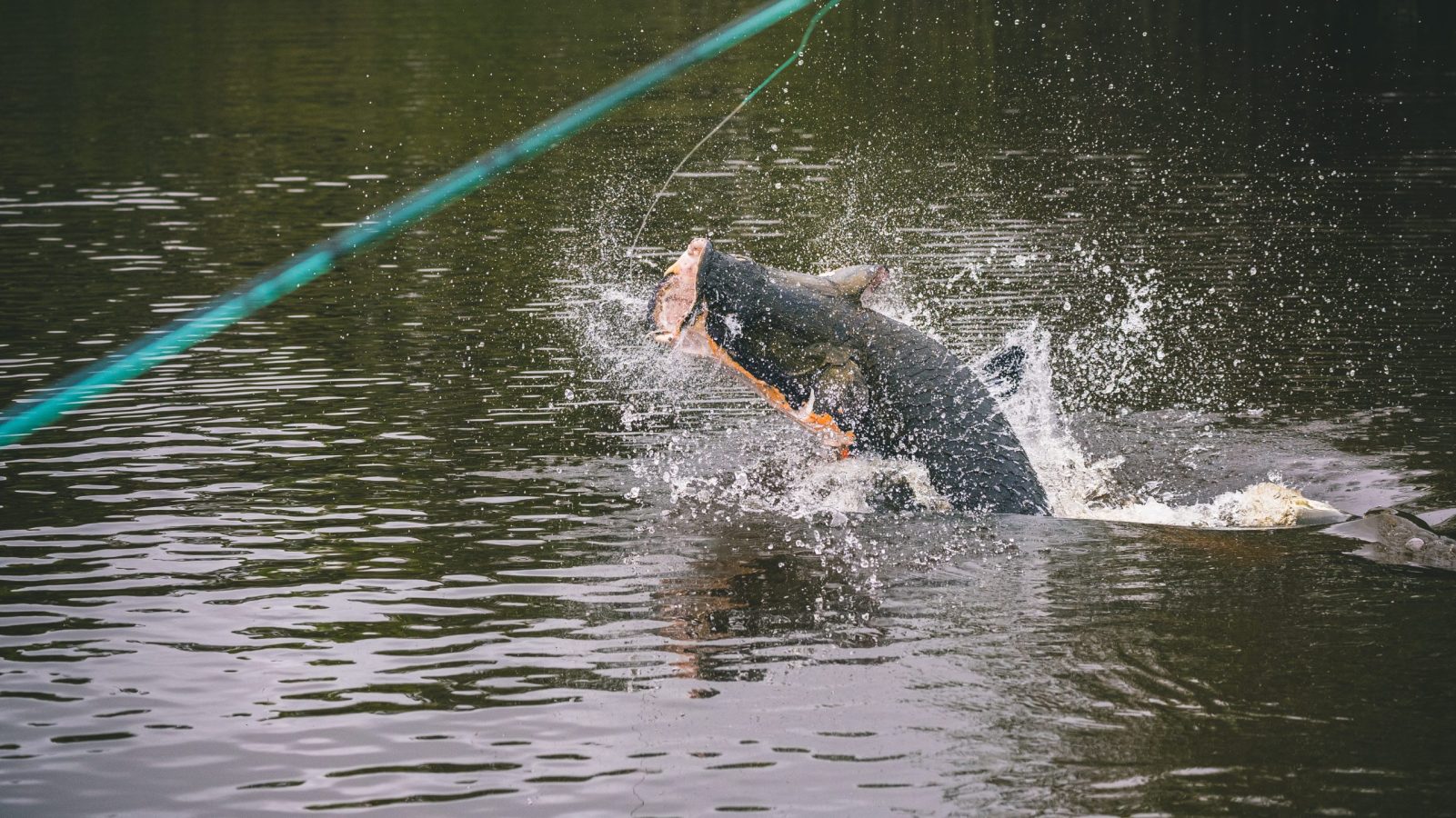Kingdom of the Black Arapaima
The creek slithers lazily through tropical undergrowth in serpentine loops before pouring us into a hidden lake walled in by towering greenery. The air is still and heavy, the water’s surface a mirror. Nothing moves nor makes a noise as we glide for a long moment. Then, in symphony, cicadas begin to shriek, echoed by countless birds as howler monkeys bellow from the bowels of the jungle. Finally, 50 yards off, what could be confused for a dolphin shatters the still surface to suck air.
Guides Carlson and Bugs tilt the outboard and dip hand-carved paddles to propel the aluminum canoe as baitfish scatter like rain ahead of marauding peacock bass. I strip half the fly line out of the 12-weight reel, clutching a 12-inch-long white streamer I tied with yak tail. Dan drops his jacket in the hull and the guides groan in disapproval; there is little room for error in the kingdom of the arapaima. I make sure not to breathe too loudly.
We glide onward as fish rise sporadically along the far shore. Subtle ripples countercurrent with those of the wind disperse fine bubbles along a bank of guava bushes blooming out of the high water. Then I see it: a wraith in black shapeshifting in the murk, now here and now there, appearing to be in several places at once.
Arapaima gigas, the largest of several species in the genus, have been recorded past 400 pounds and 10 feet long. Rumors suggest larger exist. Obligate air breathers, these giant fish rise to gulp every 10 to 20 minutes, briefly revealing their whereabouts to anglers perched atop the bow of a river canoe. It’s a tactic allowing them to survive hypoxic conditions that would kill most fishes in the low-water dry season, perfectly suiting the leviathans to their backwater lagoons and lakes. In many ponds up Guyana’s Rewa River it’s not uncommon to see dozens of arapaima rise in a session—and the average fish might be in the ballpark of 100 pounds. The oldest specimens are wise, but the short season and staggering remoteness only puts anglers in their vicinity a handful of times a year.
When a fish rises nearby, you typically have but a few seconds to start swinging the 12 weight, haul line, launch and land your bulky fly in proximity of the fish’s face before it sees you or sinks out of sight. Get it close enough and you may be treated to perhaps the most violent take available on the fly: a powerful tail sweep and a jaw crunch you can hear from 40 feet away. Strip-set properly, and you may well lock into a black-scaled giant beyond 300 pounds. Landing her, however, is another story entirely.
Arapaima are the largest scaled freshwater fish on Earth. Also known as “pirarucu” in Brazilian Portuguese, they’ve vanished from much of their native range in the Amazon Rainforest due to intensive commercial and subsistence fishing. The Essequibo Drainage, flowing northerly through Guyana to the Caribbean, stands as a stronghold thanks to relatively recent government regulations and a local embrace of conservation, ecotourism, and adventure angling. The Rewa River and its oxbows are likely the world’s best location to encounter these unbelievably large fish. River guides, all Macushi and Wapishana natives from the Rewa Village, view their arapaima as sacred, refusing to kill or even excessively manhandle the fish. But they’re certainly fond of seeing them up close.
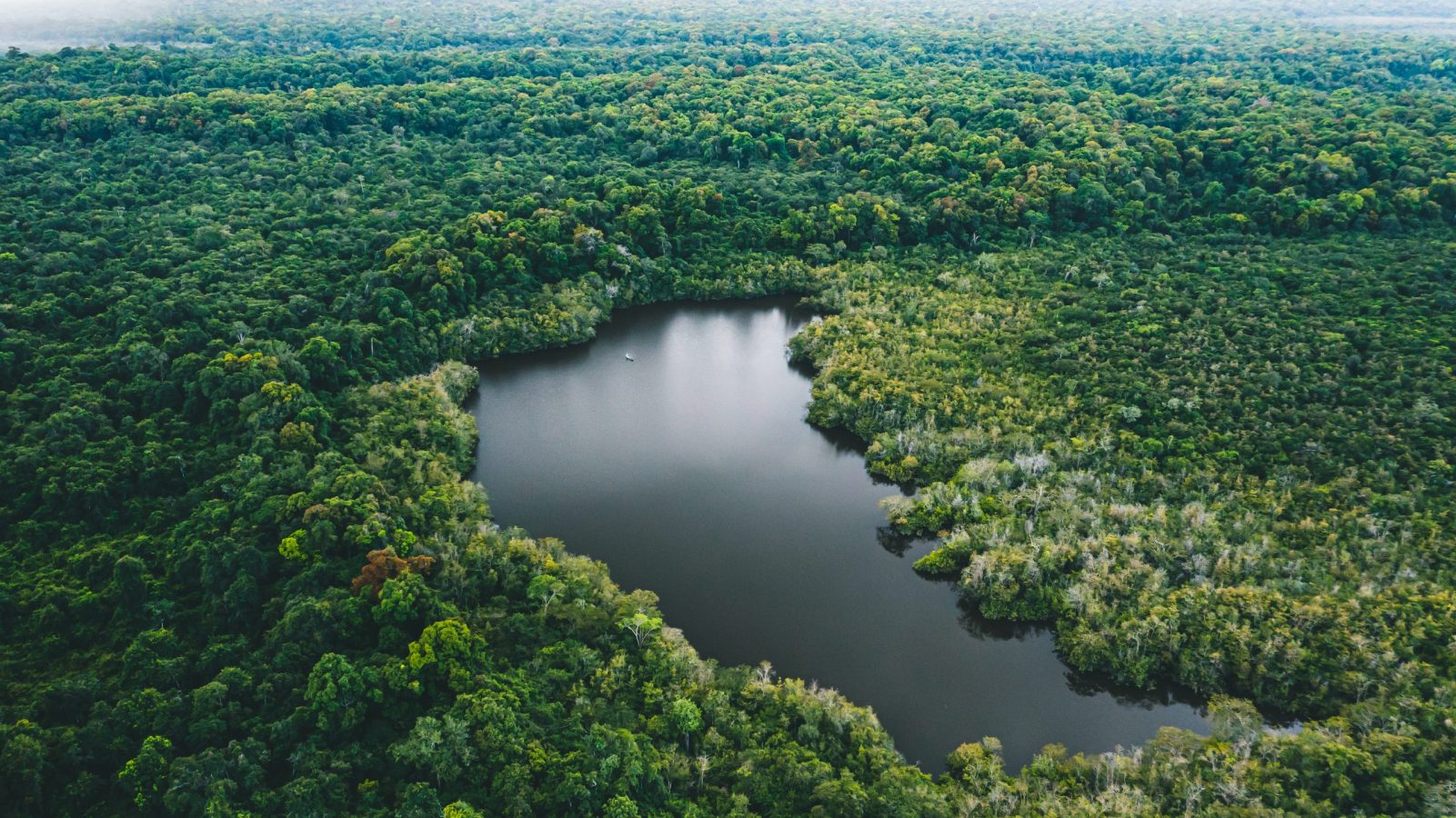
Guyana is among the world’s poorest countries economically but among the richest in biodiversity. Temperate rainforests cover much of the nation, and it’s a nature lover’s paradise with more than 800 other native bird species along with even more species of reptiles and charismatic mammals such as capybara, spider monkeys, tapirs, giant river otters, and jaguars.
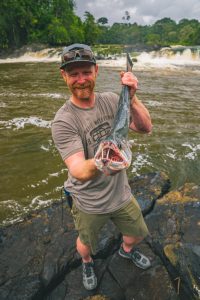
Sam Lungren handles a payara paying close attention to those teeth.
But it’s the fishes that draw the most adventurous travelers to this small English-speaking nation wedged between Venezuela, Suriname, and Brazil. Though not paying tributary to the Amazon Basin Proper, the headwaters of the Essequibo do connect with those of the Rio Branco, an Amazon affluent, during certain floods. That could explain why many of the same or similar leviathans lurk in the Guianas Region, so named with the native word meaning “land of many waters.”
Butterfly peacock bass here are so plentiful as to frequently negate the need for packing lunch—the Macushi and Wapishana love nothing more than to spatchcock a ‘cock over greenwood fire to pick apart and devour by hand. A much larger species of cichlid-bass downstream, the falls lukunani, was first described by scientists only three years ago.
Black piranhas up to 10 pounds veer quickly from novelty to irritation when your line suddenly goes tight, then slack, and your fly is no more. Their herbivorous cousin, the pacu, however, draw easy comparison to permit for their flighty and fickle nature as well as that same dinner-plate profile. The vampiric payara are far less cautious, gnashing topwater presentations with 5-inch fangs that conveniently insert into sockets in their skull. Slender and acrobatic arowana and bicuda, also known as swordfish, readily attack shiny streamers, shearing just under the surface in pursuit. A host of ornate and muscular catfishes provide great diversion and table fare in the waning hours of the day.
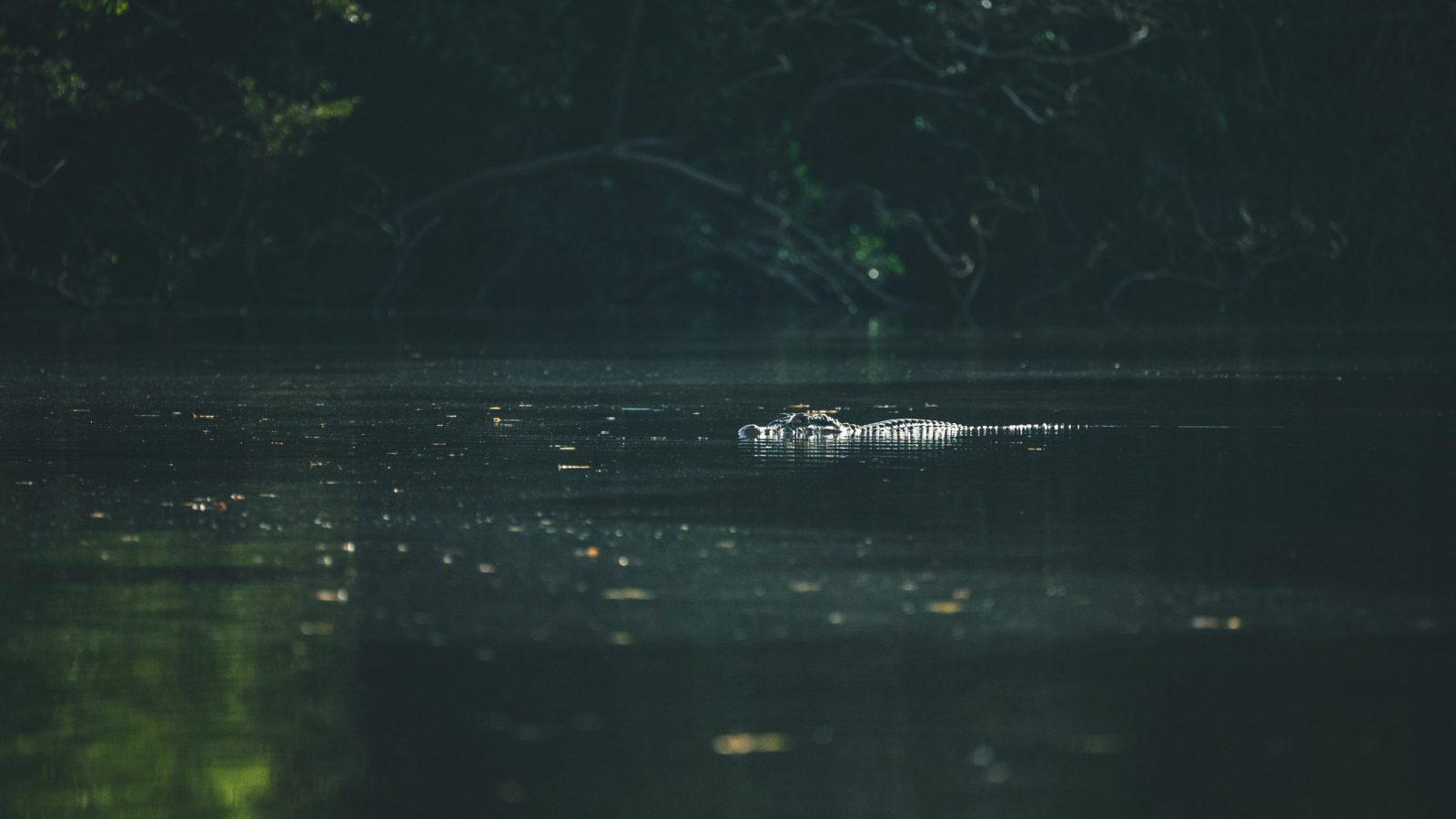
A black caiman patrols the waters.
Outfitter Jules Fredericks of Barefoot Fishing Adventure Tours operates a jungle camp about three hours upriver from the Rewa Village. It’s less than half the price of the luxurious Rewa Ecolodge for less than half the amenities. Head guide Terry Haynes helped pioneer the arapaima sport fishery near his home in the village as well as the virgin jungle far upstream, developing an unsurpassed apprehension for the landscape and its creatures—both aquatic and terrestrial.
Their Anteater Camp nestles into an inside bend in the river, sheltered from the beating sun and rain by a canopy of trees and stretched tarps. The base revolves around a massive hardwood picnic table often piled with fishing gear when it’s not supporting heaping pots of curry and fried fish. A generator provides power to a chest freezer and charging cables as well as Christmas lights running throughout the structure. In the next “room” hang somnolent hammocks draped with mosquito net, beyond which are two pit toilets and a gas-powered shower.
Jules and Terry also utilize a spike camp a few more hours upriver. It sits above a broad beach to access the mighty Corona Falls—made famous by River Monsters’ Jeremy Wade and my former employer, Steven Rinella of MeatEater. It’s the realm of pacu, petroglyphs, wolf fish, and uncontacted tribes. But those are stories for another time.
Suffice it to say that this is not an expedition for the faint of heart—or stomach. Much of the jungle is on the menu. We tasted fresh tree fruits, bush pig, jungle duck, catfishes, and giant river turtle—including their soft-shelled eggs. Venomous snakes, including the fearsome fer-de-lance, are present. A large caiman tried sneaking up on me while I bathed in the river one night, his wicked eyes glowing red in the beam of my headlamp. Caustic spiders, scorpions, and bullet ants threaten a nasty wound or worse. Gil Greenberg, founder of Fly Fishing International and trip organizer, described how a few years prior a friend of his nearly stepped on a jaguar while searching for a tree to squat behind. It’s also entirely possible to be bludgeoned or drowned by the very fish you’ve traveled all this way to fight.
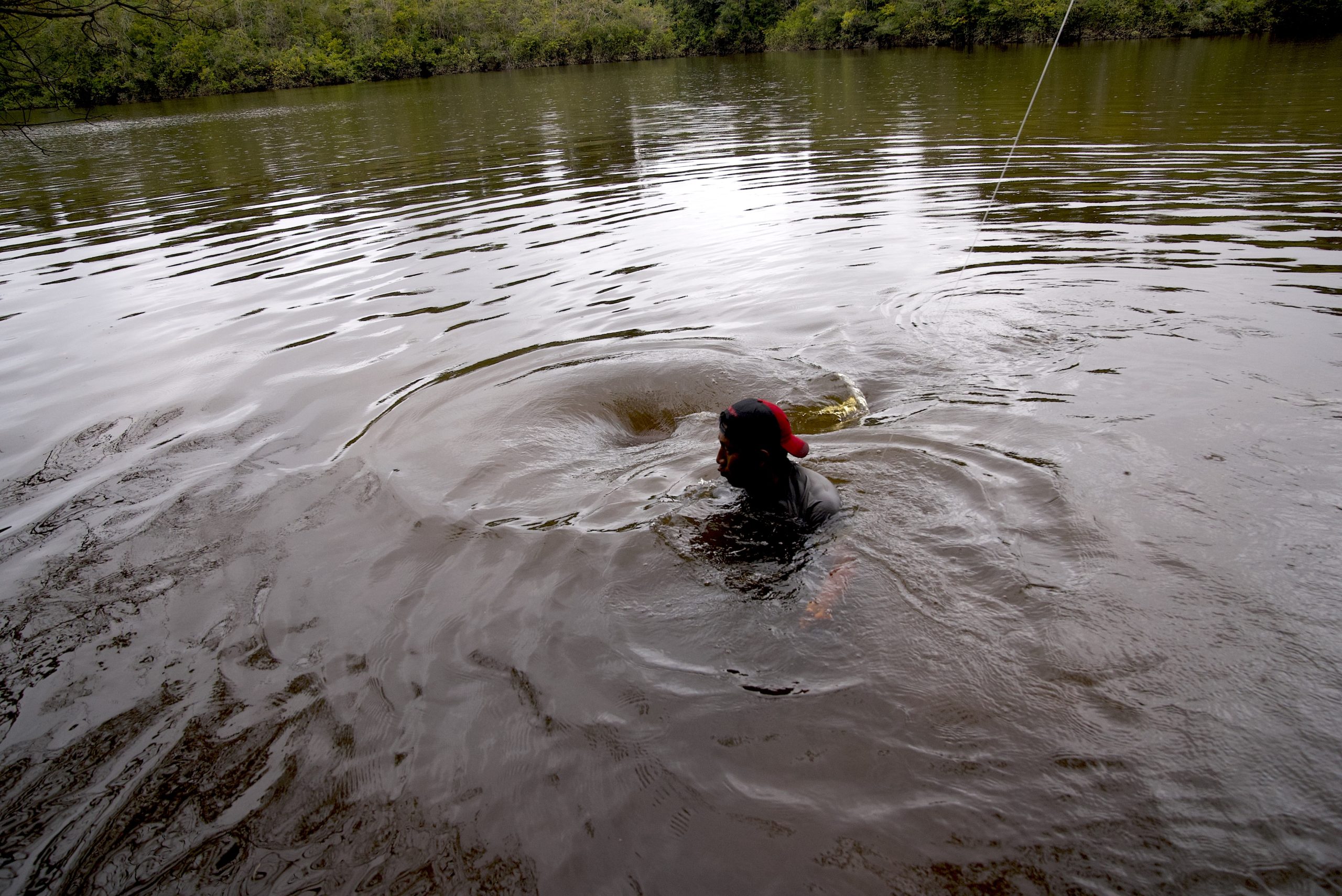
Guide Carlson meets the arapaima in its element.
An audible crunch, and my whole body jolts like I hooked a horse in the haunches. The seventh cast to the shadow seethes back away from the boat. I grip and yank desperately at the fly line flying away as if trying to break the 80-pound fluorocarbon at the end. Then the massive weight slows, flexes, and explodes upward into a battering, head-shaking tailwalk. Basketball-sized mouth thrown wide, matte black scales the size of limes trail into a broad tail speckled with red. A slash of orange roughly the length of two average cutthroat trout runs the lower span of the flared gill plate.
The fish plows off, more deliberately now, unaffected by my attempts to drive home the 10/0 hookpoint and my dream of turning its head. With the line half-wrapped on my hand, the fish simply tows the whole boat. Then it slows again.
Carlson urges me to bury the rod tip when the fish comes up to breathe. “Don’t give her more power,” he warns.
I pull even harder but the immovable force surges onward and upward into another heavy jump. I figure nose to tail couldn’t quite reach from a basketball hoop to floor—but it’s not far off.
Forty-five minutes drag by as the fish drags us around the back end of the small lake, occasionally rearing to leap and slap the still surface. By and by, the power transfers to Carlson and Bugs backpaddling their craft toward an embankment of flooded trees where they believe the “shoreline” is shallowest. As I fight the fish away from the vegetation and Bugs holds us to it, Carlson quietly slips over the gunwale and into the water, vanishing over his head. He emerges with a breaststroke toward the fish that quite obviously doubles his bodyweight.
The Wapishana warrior swims calmly, reaching out to grab the leader.
The arapaima boils off, rocking the boat with its tail sweep hydraulic.
The scene plays out again, this time Carlson brushes the fish’s flank as it passes. And again. This time he slows it with the leader as if drawing a bowstring before reaching one arm gently over its wide back, the other under its belly. He barely links his hands. Then he’s thrown sideways as 9 feet of muscle heaves away.
I lean break-bend into the 12-weight to rope the mustang back around toward the wet but unfazed wrangler. Just before they meet, the fish slows. Tilting its crocodilian head up through the surface, it swells, breathing deeply. It rears up, holding the pose for three tailstrokes, water blowing from the maw, before crashing down.
I feel the jaws pop wide again underwater and the fly comes flying toward me.
I sit down, slightly shaking. A draw, a détente. No one won. No one lost. It’s probably best to not wrestle old, fecund females into submission anyway. Where in the hell could we have landed it with no land? It most assuredly would have sunk the boat. Still I kick myself for somehow letting it throw the hook.
Dan assures me that holding the leader and touching the giant qualifies as a catch under the auspices of the International Game Fish Association. You do feel more like you caught a fish when you have a great photographer capturing its jumps. It’s still not quite capturing your quarry.
Back at camp Jules explains that certain females will trade their typical green-orange-bronze pigmentation for that olive-black with red accents once they exceed a certain age that might roughly correspond with the range of 300 pounds. The final night, long after I’d been body-slammed by half a dozen other almost-as-giant specimens, he digs up a photo from the same pond a year prior. Clearly the same fish drapes between Jules and two other big guys waist deep in much lower water. Enormous.
Who knows what it weighed. Who cares whether we in fact “caught it.” Counting coup is close enough. Mystery defines this kingdom of the black arapaima, only barely within the reach of modern man. It demands my return like a curse.
Gil Greenberg and I are both hosting trips with Barefoot Fishing Adventure Tours in 2024. Seats are still available, and you can click here to learn more. We can also recommend and assist with the booking, planning, and travel to numerous vetted lodges across South and Central Americas—or anywhere else on Earth you might want to go fishing.
